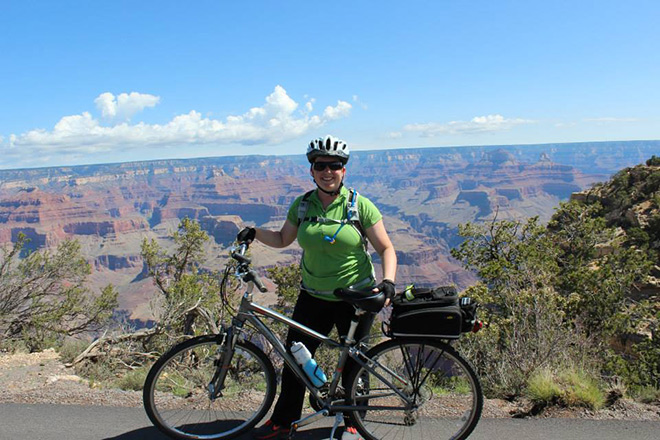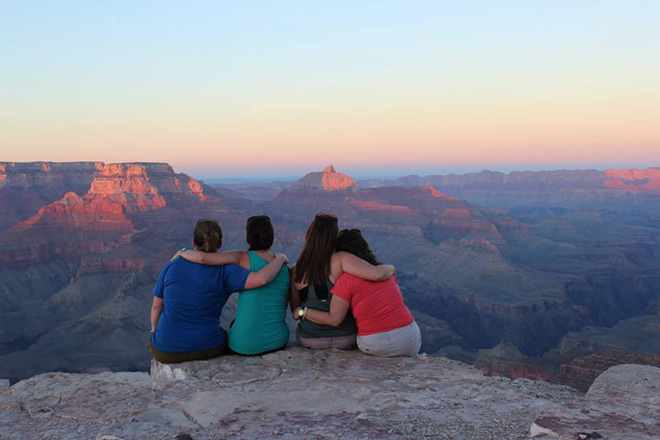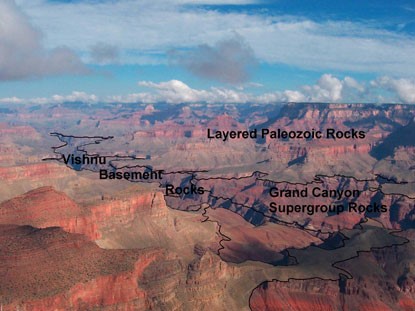America’s Southwest is full of amazing canyons, but none perhaps as famous or as widely visited as the Grand Canyon. This world-famous landmark is actually the youngest of the canyons in the region, despite its immense size. The Colorado River has been carving its way through the Southwest for nearly 70 million years, but the Grand Canyon is only 6 million years old.
Spanning 277 river miles and measuring a mile deep and up to 18 miles wide in some places, this canyon offers wondrous views, great whitewater rafting, and countless adventures. One look across the enormous chasm confirms just why this inspirational place is one of the seven natural wonders of the world and a must-see destination for so many travelers.
Keep in mind that the park’s two main regions, its North and South Rims, are physically only 10 miles apart, but driving from one area to the other is a 215-mile journey.
North Rim
The North Rim of Grand Canyon National Park is more remote and at a higher elevation than the South Rim. Though exploring this side of the canyon is a good way to get away from the crowds, this part of the park is only open May 15 through October 15. Here are things to keep in mind if you go during the warmer months.
- Be sure to check in with park rangers at the visitor center for hiking suggestions, trail conditions, and weather advisories.
- Consider staying in one of the rustic cabins along the canyon edge—you’ll wake up right on the rim of the canyon.
- Hike the 30-minute round-trip Cape Royal Trail to see a great sunrise.
South Rim
The South Rim is easily accessible and offers many amenities, including camping, hotels, a post office, and a general store. The two main visitor facilities, Grand Canyon Village and Desert View, are open year-round.
- Visitor centers. Be sure to visit Grand Canyon’s visitor centers to learn about special events and weather precautions, and to speak with rangers for personalized suggestions on what to do while you visit.
- Desert Tower. Make a point to stop here. It is the highest point on the rim and offers beautiful views of the canyon. You can also find food, gas, and stores here.
- Rent a bike. Rent a bike at Bright Angel Bicycles in Mather Village and see the canyon in a very different way. The park is surprisingly bike-friendly, with numerous paved roads and wide shoulders for two-wheeled traveling. Mather Village also offers a great place to grab a cup of coffee or a quick bite to eat.
- Hermit’s Rest. Hermit Road has eight overlooks and at the far end is Hermit’s Rest. Here you can find a snack bar, shop, bathrooms, and stunning views of the Grand Canyon. You can access Hermit’s Rest by shuttle or bike or by hiking the Rim Trail. Stunning views can be found all the way to Hermit’s Rest.
- Kaibab Hiking Trail. After looking down into the canyon from the overlooks, take a hike down Kaibab, as far as you want to go. Ooh Ahh Point may sound funny, but it’s completely accurate –with every turn, the canyon provides new surprises and dazzling views that never get old.
- Sunset and sunrise. Don’t miss the spectacle of the sun rising and setting over the Grand Canyon. All along the rim, beautiful reds, golds, and purples highlight different dimensions of the canyon walls. Some places to watch:
- Hopi Point and Mather Point have great views to both the east and west of the canyon, but can be very congested due to popularity.
- Yaki and Yavapai points also offer fantastic views with fewer crowds
- If you want to catch a great sunrise, hike down the Kaibab trail to Ooh Aah Point for a stunning display of the sun rising. This secluded destination provides great views down the canyon. Be sure to hike down early and bring a flashlight!
Moran Point. Named after 19th century landscape painter Thomas Moran, three distinct geologic layers of the canyon are clearly visible at this site:
- Layered Paleozoic Rocks—the sedimentary rocks that make up most of what is visible in the canyon walls.
- Grand Canyon Supergroup—the middle layer of rock that is only visible at a few spots along the rim.
- Vishnu Basement Rocks—the oldest and deepest parts of the canyon walls.
- Whitewater raft. It may seem peaceful to look down into the canyon, but it can be a roller coaster of a ride looking up. Many different outfitters offer single-day and multi-day trips down the Colorado River where you can explore the canyon bottom, hike out to waterfalls, and enjoy the secluded and biodiverse river edge of the Colorado River in the Grand Canyon.
These are just a few things that Grand Canyon National Park has to offer, but no matter which trail or activity you choose, it is all but impossible to go wrong. Even if you are passing through and only have a few hours to visit this park, it is a must-see. I recommend that everyone experience this natural wonder at least once—if not many times.
This story is part of NPCA’s biweekly Desert Getaway series. Read more stories in the series for tips on visiting other desert parks.
About the author
-
 Megan Cantrell Former Social Media Manager
Megan Cantrell Former Social Media ManagerMegan Cantrell worked at National Parks Conservation Association for 10 years, much of that time shepherding NPCA’s social media program.


